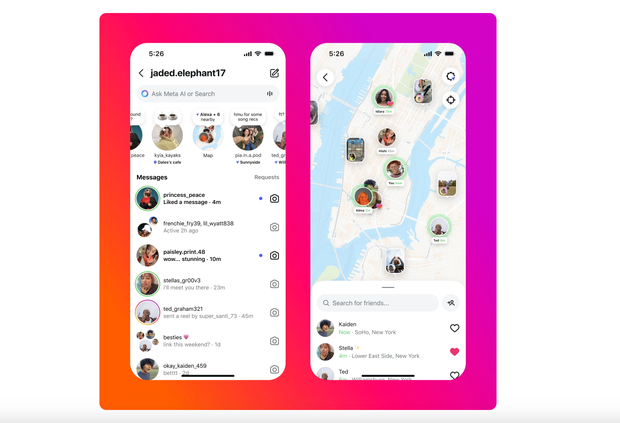
A new feature on Instagram that let’s users share their real-time physical location with others on the app has privacy experts concerned over the amount of data exposed and potential safety risks to users.
Called Instagram Map, the new feature was introduced on Thursday as part of an app update. On its blog, the company says the location-sharing tool makes it “easier for you and your friends to stay in touch through the content you’re enjoying on Instagram.”
“You can opt into sharing your last active location with friends you pick, and you can turn it off anytime,” Instagram said in a blog post announcing the new feature. “You can also open the map to see content your friends and favorite creators are posting from cool spots. No matter how you use the map, you and your friends have a new, lightweight way to connect with each other.”
“Off by default”
In a statement shared with CBS MoneyWatch Friday, Instagram’s parent company, Meta, emphasized that Instagram Maps is not automatically active upon updating the app and that users must opt-in to the location-sharing feature in order to make their whereabouts visible to others.
Instagram
“Instagram Map is off by default, and your live location is never shared unless you choose to turn it on. If you do, only people you follow back — or a private, custom list you select — can see your location,” a Meta spokesperson said in a statement to CBS MoneyWatch.
Users can also choose not to share their locations when they are in particular places, or with particular people.
Still, privacy experts say that social media users aren’t always aware of how much information they’re sharing with an app or its users, even if they have the ability to limit who sees what.
“The more these location features are rolled out on social media it carries out the assumption that as long as you give users the ability to toggle them on and off that they’ll know exactly how to do that,” Douglas Zytko, an app safety expert and associate professor at the College of Innovation & Technology at the University of Michigan-Flint, told CBS MoneyWatch. “But the average user isn’t always aware of their privacy settings and if they match their preferences.”
When the Instagram Map feature is turned on, any content a user posts with a location tagged, including a reel, post or story, will show up on the app’s map for 24 hours, according to the Instagram blog. While the feature remains on, the user’s location is updated whenever they open the app or return to it. The feature can be turned off at any time.
In an Instagram post discussing the feature, Instagram’s head, Adam Mosseri, explains how he himself uses the map. “Personally, I use the map to share what I’m up to with a handful of my closest friends, and I curate that list carefully,” he said.
User confusion over whether the feature is on or off
On Threads, Meta’s microblogging site, a number of Instagram account holders claimed that their locations were being pinned on friends’ maps by default.
Mosseri weighed in, saying the concerns prompted the company to re-examine how the feature works.
“We’re double-checking everything, but so far it looks mostly like people are confused and assume that, because they can see themselves on the map when they open, other people can see them too,” he said. “We’re still checking everything though to make sure nobody shares location without explicitly deciding to do so, which, by the way, requires a double consent by design (we ask you to confirm after you say you want to share).”
How to turn on Instagram Maps
In the top right corner of the app, tap on the messaging function. There you will see a circular world map icon labeled “map. If you click on the icon, you will see you’re on location pinned on a map. Friends who are sharing their locations will also appear. Click on the gear icon to choose to share your location with no one, or a custom list of friends, or all of your friends — who are followers that you also follow back on the app.
Social pressures, privacy and safety risks
Zytko, however, said it can be complicated for social media users to manage privacy settings that let them share different kinds of content with different groups of people. “This issue is called ‘context collapse,'” he said. “Your co-workers see your social media posts, and your friends and family, and there is certain content you only want some groups to see but not others, and it can be hard to manage the visibility of content.”
Robbie Torney, senior director of AI programs at Common Sense Media, which makes entertainment and technology recommendations for families, said location-sharing features can be particularly risky for younger app users.
“These features might feel fun and social, but they create unnecessary risks that teens and many adults don’t necessarily understand,” he told CBS MoneyWatch.
While parents who supervise their teens through controls built into the app can control their kids’ location-sharing settings, he still has concerns about the kinds of social pressures such features expose teens, too.
Torney said research at Common Sense Media shows that location-sharing also creates “social pressures around where teens go and who they spend time with, and kids feel obligated to share location to show they are someplace cool.”
Furthermore, when teens share their locations, “they are potentially telling strangers where they are in real time,” Torney told CBS MoneyWatch. “If you’re not selective about who you’re sharing your location with, it creates opportunities for harassment, stalking or worse.”
 Latest World Breaking News Online News Portal
Latest World Breaking News Online News Portal







